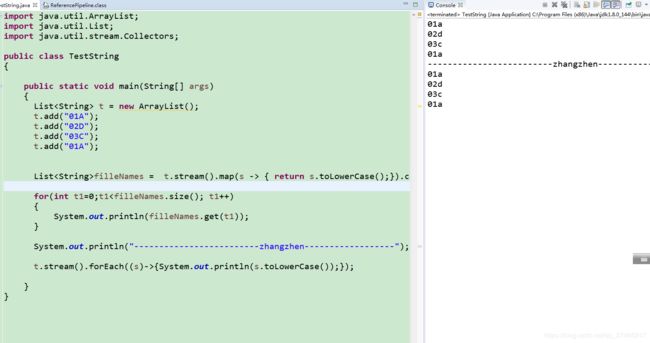- Java学习第五十八部分——设计模式
慕y274
java学习设计模式
目录一、概述提要二、创建型模式——解决“如何创建对象”的问题1.单例模式(Singleton)2.工厂方法模式(FactoryMethod)3.解释器模式(Interpreter)4.建造者模式(Builder)5.原型模式(Prototype)三、结构型模式——解决“如何组合类和对象”的问题1.适配器模式(Adapter)2.桥接模式(Bridge)3.组合模式(Composite)4.装饰器模
- 事务注解可能失效的几种可能原因
℡余晖^
黑马点评项目相关问题和笔记javajvm开发语言
在黑马点评项目的学习过程中,我遇到了事务失效的问题,其中提到了事务失效的可能原因,本文就来简单了解一下事务实现的可能原因是什么。Spring事务的生效机制、自调用失效原因及常见失效场景,可从以下维度详细解析:一、Spring如何确保事务生效?Spring事务的核心实现依赖AOP(面向切面编程)和动态代理,其核心流程如下:1.代理对象的生成Spring通过@Transactional注解标记需要事务
- Java自动拆箱机制
在黑马点评项目中,提到了一个细节,就是Java的自动拆箱机制,本文来简单了解一下。Java的自动拆箱机制(Unboxing)是一种编译器层面的语法糖,用于简化包装类对象(如Integer、Boolean、Long等)与基本数据类型(如int、boolean、long等)之间的转换。它的核心作用是让开发者无需手动调用intValue()、booleanValue()等方法,即可直接在包装类对象和基本
- 每日面试题11:JVM
深入理解JVM:Java的“心脏”如何驱动程序运行?为什么需要JVM?你是否想过,为什么用Java写的程序,能在Windows、Linux、macOS上“无缝运行”?为什么开发者无需为不同操作系统重写代码?这背后的核心功臣,正是Java虚拟机(JavaVirtualMachine,JVM)。JVM是Java生态的“基石”,它不仅实现了“一次编写,随处运行”的跨平台特性,还通过内存管理、垃圾回收等机
- 自编码器表征学习:重构误差与隐空间拓扑结构的深度解析
码字的字节
机器学习自编码器重构误差隐空间
自编码器基础与工作原理自编码器(Autoencoder)作为深度学习领域的重要无监督学习模型,其核心思想是通过模拟人类认知过程中的"压缩-解压"机制实现数据的表征学习。这种由GeoffreyHinton团队在2006年复兴的神经网络结构,本质上是一个试图通过编码-解码过程来复制其输入的系统,却在实现这一看似简单目标的过程中,意外地获得了强大的特征提取能力。基本架构与工作流程典型自编码器由对称的两部
- 深入解析Hadoop中的Region分裂与合并机制
码字的字节
hadoop布道师hadoop大数据分布式Region分裂合并
Hadoop与Region的基本概念Hadoop的分布式架构基础作为大数据处理的核心框架,Hadoop通过分布式存储和计算解决了海量数据的处理难题。其架构核心由HDFS(HadoopDistributedFileSystem)和MapReduce组成,前者负责数据的分布式存储,后者实现分布式计算。在HDFS中,数据被分割成固定大小的块(默认128MB)分散存储在集群节点上,而MapReduce则通
- 深入解析Hadoop RPC:技术细节与推广应用
码字的字节
hadoop布道师HadoopRPC
HadoopRPC框架概述在分布式系统的核心架构中,远程过程调用(RPC)机制如同神经网络般连接着各个计算节点。Hadoop作为大数据处理的基石,其自主研发的RPC框架不仅支撑着内部组件的协同运作,更以独特的工程哲学诠释了分布式通信的本质。透明性:隐形的通信桥梁HadoopRPC最显著的特征是其对通信细节的完美封装。当NameNode接收DataNode的心跳检测,或ResourceManager
- Java数据结构之用双向链表实现栈的入栈和出栈操作
packageLinkList;//使用双链表定义栈的基本操作publicclassStackByDoubleLinkextendsDoubleLinkList{//栈继承自双链表//DoubleNodehead=null;//双链表压栈操作---向双链表插入一个元素publicvoidpush(inta){HeadInsertLinkList(a);//返回压栈后的链表}//双链表出栈操作---
- Java全栈开发性能优化全攻略:从数据库到前端
AI天才研究院
计算AI大模型企业级应用开发实战AI人工智能与大数据java性能优化数据库ai
Java全栈开发性能优化全攻略:从数据库到前端关键词:Java全栈、性能优化、数据库索引、后端缓存、前端渲染、响应时间、系统瓶颈摘要:本文从全栈视角出发,系统讲解Java开发中数据库、后端服务、前端页面三大核心层的性能优化方法。通过生活类比、代码示例和实战案例,带你一步步理解索引设计、缓存策略、懒加载、防抖节流等关键技术,掌握从“发现瓶颈”到“精准优化”的完整流程,最终实现用户体验与资源效率的双重
- 深入解析Hadoop:大数据处理的基石
学习的锅
hadoop大数据分布式
随着信息技术的快速发展和互联网的普及,数据的产生速度极具增加。面对如此海量的数据,传统的数据处理工具显得力不从心。在这种背景下,诞生了一系列用于处理大数据的框架与工具,而ApacheHadoop便是其中最为知名和应用最广泛的一个。本文将深入解析Hadoop的基本原理、架构及其在大数据处理中的重要性。1.Hadoop的起源与发展Hadoop起源于Google公司的三篇奠基性论文:GoogleFile
- 简悦音乐播放器用到的相关技术点都在这里了(一)
那年星空
flutterandroidios
基于Getx实现的MVVM在原生的iOS、Android中我们已经习惯了使用MVVM取代MVC,来实现业务页面,这样结构更加清晰,也便于管理和功能扩展。在Flutter通过Getx来实现MVVM,如播放器的首页的实现,简化之后的代码如下。View的实现:在View中实例化一个HomeController并交给Get,build方法中返回一个由GetBuilder(builder:(controll
- 鸿蒙分布式数据同步全解析:用一套代码搞定多设备实时共享
前端世界
harmonyosharmonyos分布式华为
摘要在万物互联的趋势下,多设备间的数据协同成了刚需。从手机到平板、手表、电视,再到智能车载系统,用户希望数据无缝同步、实时一致。鸿蒙系统通过分布式数据库与分布式消息总线,为开发者提供了一套跨设备的数据同步机制,简化了开发流程。本文将从实际开发角度出发,带你用最简单的方式了解如何实现跨设备的数据同步。引言过去,我们经常需要自己去写Socket通信、同步逻辑、数据一致性校验,整个过程又难又容易出错。而
- lab2-2 Dijkstra算法求由顶点a到顶点h的最短路径
西一安鲜
算法
1.问题[描述算法问题,首选形式化方式(数学语言),其次才是非形式化方式(日常语言)]对于下图使用Dijkstra算法求由顶点a到顶点h的最短路径,按实验报告模板编写算法。2.解析Dijkstra算法(单源点路径算法,要求:图中不存在负权值边),Dijkstra算法使用了广度优先搜索解决赋权有向图或者无向图的单源最短路径问题,算法最终得到一个最短路径树。Dijkstra(迪杰斯特拉)算法是典型的
- Provider 做 状态管理 和 路由管理 及 与其他方案对比
ideal树叶
Flutterflutter
Provider是Flutter官方推荐的状态管理解决方案,它基于InheritedWidget实现,通过依赖注入的方式高效管理应用状态,避免深层嵌套传值问题。以下从原理、核心组件到实践代码全面解析:一、Provider做状态管理1.1核心原理1.基于InheritedWidgetInheritedWidget是Flutter的特殊组件,用于在widget树中自上而下高效传递数据。子组件可通过co
- Java 数据结构篇-用链表、数组实现栈
2401_86450001
java数据结构链表
2.7用链表实现栈的完整代码3.0用数组来实现栈3.1实现栈-入栈(push)3.2实现栈-出栈(pop)3.3实现栈-查找栈顶元素(peek)3.4实现栈-判断是否为空栈(isEmpty)3.5实现栈-判断是否为满栈(isFull)3.6实现栈-重写迭代器3.7用数组实现栈的完整代码1.0栈的说明栈是一种数据结构,它具有后进先出(LIFO)的特性,即最后入栈的元素最先出栈。栈通常可以通过数组或链
- 目前市面上佣金最高的十款返利APP解析
直返APP京东优惠券
随着网购的普及,返利APP成为了越来越多人的购物助手。那么,2024年最好用的购物返利APP是哪个?今天,我们将为您推荐十款2024年最值得推荐的返利APP,助您在购物中享受更多的优惠。一、直返直返的口号是“返利就用直返”,它强调没有上级赚差价,直接为用户提供商家和消费者之间的综合优惠券返利平台。用户可以在直返上获取自己感兴趣的商品,购买后可以获得一定比例的返利。直返的返利速度快、金额高,深受用户
- 【Python 语法】Python 神经网络项目常用语法
一杯水果茶!
人生苦短我用Pythonpython
基础1.导入模块和包2.修改系统路径(sys.path.append)3.命令行参数解析(argparse模块)4.assert确保正确性5.main()脚本入口点6.辅助函数生成器函数`cycle(dl)`一、常用函数1.`.cuda()`/`.cpu()`和`torch.device`2.`torch.zeros`、`torch.randn`、`torch.arrange`、`torch.po
- 【Linux内核】Linux驱动开发
撬动未来的支点
Linux内核linux驱动开发运维
推荐书籍:《Linux内核探秘:深入解析文件系统和设备驱动的架构与设计》知识点x86的IO地址空间和内存地址空间是独立的两套地址空间,并且使用不同的指令访问。MOV,IN,OUT。内存映射I/O可以将IO映射到内存。ARM等RISC采用统一编编址,无独立IO空间概念。为什么有IO地址空间的概念。因为在PCI总线下,外部芯片都有控制寄存器(配置空间)和设备本地内存(内存空间)两个部分,他们是独立的。
- XML数据如何进行解析呢,方式有哪些?
张起灵的小可爱啊
上回我们说到JSON解析的四种方式,那么这次我们来看看XML的四种解析方式。解析的四种方式DOM解析SAX解析JDOM解析DOM4J解析案例实操DOM解析DOM(DocumentObjectModel,文档对象模型),在应用程序中,基于DOM的XML分析器将一个XML文档转换成一个对象模型的集合(通常称为DOM树),应用程序正是通过对这个对象模型的操作,来实现对XML文档数据的操作。XML本身是以
- 春季招聘数字化:智能招聘如何升级面试流程?
人事百宝箱
面试流程优化面试流程数字化面试流程优化招聘数字化
2025年春季招聘季,全球企业面临着双重挑战:既要应对人才争夺战,又要在AI技术革命中重构招聘体系。数据显示,采用数字化面试流程的企业,人才录用效率提升47%,候选人体验满意度提高39%。在智能招聘时代,传统依赖人工的面试模式已难以适应快速变化的市场需求,企业需要通过数字化升级实现降本增效与体验优化的双重目标。本文将从行业趋势出发,解析春招面试流程的数字化升级路径,并深度解读Moka人力资源管理系
- Javaweb笔记
笙鹿鸣
html前端html5
HTMLHTML网页常用基础知识网页结构JavaSEC/SClientserver客户端–服务器JavaWebB/SBroswerServer浏览器–服务器网页的组成部分:内容(结构)、表现、行为HTML:HyperTextMarkupLanguage(超文本标记语言)ALT+F2选择浏览器HTML书写规范:表示整个html页面的开始头信息标题标题body是页面的主体内容页面主体内容表示整个htm
- 一文搞懂 Smali 与 Baksmali:Java 层逆向必备技能
CYRUS STUDIO
java开发语言逆向androidsmalibaksmali
版权归作者所有,如有转发,请注明文章出处:https://cyrus-studio.github.io/blog/smali与baksmalismali和baksmali是用于Android平台中DEX文件的汇编器和反汇编器,广泛应用于Android逆向分析与调试。smali和baksmali是一对工具,分别用于:smali:将smali代码(Java汇编语言)编译成DEX文件。baksmali:
- 解锁发动机潜能:深入解析现代宽域空燃比测量技术
Triv2025
高性能调校必备工具ECU调校空燃比工具涡轮增压空燃比优化赛车发动机空燃比监测高分辨率AFR传感器
在追求极致动力与效率的发动机调校领域,精准的空燃比(AFR)数据是解锁性能潜力的核心密码。AFR500系列空燃比监测仪自问世以来,凭借其革命性的宽域测量技术,已成为改装发烧友和专业调校师不可或缺的利器。而全新的AFR500v2版本,则在性能、兼容性和应用广度上实现了全面飞跃。一、宽域测量核心价值在于其提供了真正的宽域空燃比测量能力:测量范围:标准范围覆盖9.0:1至16.0:1(0.62-1.1λ
- Spring Cloud LoadBalancer 详解
大手你不懂
springJavaJava项目实战springcloudspring后端
在分布式系统快速发展的当下,服务间的调用日益频繁且复杂。如何合理分配请求流量,避免单个服务节点过载,保障系统的稳定性与高效性,成为关键问题。负载均衡技术便是解决这一问题的重要手段。SpringCloudLoadBalancer作为SpringCloud官方推出的负载均衡器,在微服务架构中发挥着至关重要的作用。本文将对其进行详细解析。一、SpringCloudLoadBalancer基本概念Spri
- 突破密度瓶颈:PCIe 8xCAN 多通道接口技术解析
Triv2025
网络高密度PCIeCAN接口多通道CANFDHIL测试
现代汽车电子、工业自动化及硬件在环(HIL)测试领域,高效集成大量CAN/CANFD通道已成为核心挑战。传统解决方案往往受限于物理空间和接口扩展性,导致系统臃肿且成本高昂。KvaserPCIe8xCAN的推出,从硬件架构层面提供了创新思路。核心密度:PCIex1实现8通道集成该产品的核心价值在于其“通道密度”设计:PCIex1接口承载8通道:仅需占用单个PCIex1插槽,即可提供8个独立的CAN/
- 情感主播培训有哪些项目,说说我的经历
糖葫芦不甜
作为一名从情感主播培训中走出来的“新人”,我想分享一些我所经历的培训项目以及这段经历如何塑造了我。5星公会,免费加入,一对一指导扶持↓微信在文章底部。培训的第一步,是从理论根基开始。我们系统地学习了情感解析的技巧,包括如何识别不同情绪背后的深层需求、理解人际关系的动态变化等。作为主播,声音是我们最直接的“武器”。培训中,我们接受了专业的声音训练,包括发音技巧、语调控制、情感融入等,旨在通过声音传递
- JSON和JSONL、python操作
weixin_668
jsonpython
JSONJSON(JavaScriptObjectNotation)是一种轻量级的数据交换格式,基于文本、易于读写,并支持多种数据结构。以下是常见的JSON格式及示例:1.简单对象(键值对){"name":"Alice","age":25,"isStudent":true}2.嵌套对象{"person":{"name":"Bob","address":{"city":"NewYork","zipc
- Java Spring、Spring MVC、Spring Boot 和 Spring Cloud 的关系与区别
Java皇帝
javaspringspringBootjavaspringmvc开发语言springbootspringcloud
在Java开发领域,Spring、SpringMVC、SpringBoot和SpringCloud这些框架和技术名词频繁出现。对于初学者来说,理解它们之间的关系和区别可能有些困惑。本文将深入浅出地讲解这些概念,帮助你理清它们的联系与差异。一、Spring1.1定义Spring是一个轻量级的Java开发框架,由RodJohnson创建。它基于控制反转(IoC)和面向切面编程(AOP)理念,旨在简化J
- 前后端分离项目进阶1---后端
屋外雨大,惊蛰出没
java开发语言
前端链接:前端解析一.项目目录二.关键代码分析1)Admin.javapackageimprov1.improv1.entity;publicclassAdmin{privateStringaccount;privateStringpassword;privateStringname;//构造方法、getter和setterpublicAdmin(){}publicAdmin(Stringacco
- 微信二维码扫描登录流程详解
黑塞123
QT二维码登录流程
二维码扫描登录流程细节(项目经验)1:获取二维码信息PC会优先存放服务器生成的唯一密钥:比如source、secret以密文形式存储大致发送字段:sourcesecretmac(mac地址)服务器生成二维码信息:二维码字符、二维码过期时间、二维码状态。并将mac与二维码信息绑定后2:获取二维码状态、校验二维码是否过期客户端解析二维码信息生成二维码开启定时器1:轮询检测二维码过期时间(二维码过期暂停
- PHP,安卓,UI,java,linux视频教程合集
cocos2d-x小菜
javaUIlinuxPHPandroid
╔-----------------------------------╗┆
- zookeeper admin 笔记
braveCS
zookeeper
Required Software
1) JDK>=1.6
2)推荐使用ensemble的ZooKeeper(至少3台),并run on separate machines
3)在Yahoo!,zk配置在特定的RHEL boxes里,2个cpu,2G内存,80G硬盘
数据和日志目录
1)数据目录里的文件是zk节点的持久化备份,包括快照和事务日
- Spring配置多个连接池
easterfly
spring
项目中需要同时连接多个数据库的时候,如何才能在需要用到哪个数据库就连接哪个数据库呢?
Spring中有关于dataSource的配置:
<bean id="dataSource" class="com.mchange.v2.c3p0.ComboPooledDataSource"
&nb
- Mysql
171815164
mysql
例如,你想myuser使用mypassword从任何主机连接到mysql服务器的话。
GRANT ALL PRIVILEGES ON *.* TO 'myuser'@'%'IDENTIFIED BY 'mypassword' WI
TH GRANT OPTION;
如果你想允许用户myuser从ip为192.168.1.6的主机连接到mysql服务器,并使用mypassword作
- CommonDAO(公共/基础DAO)
g21121
DAO
好久没有更新博客了,最近一段时间工作比较忙,所以请见谅,无论你是爱看呢还是爱看呢还是爱看呢,总之或许对你有些帮助。
DAO(Data Access Object)是一个数据访问(顾名思义就是与数据库打交道)接口,DAO一般在业
- 直言有讳
永夜-极光
感悟随笔
1.转载地址:http://blog.csdn.net/jasonblog/article/details/10813313
精华:
“直言有讳”是阿里巴巴提倡的一种观念,而我在此之前并没有很深刻的认识。为什么呢?就好比是读书时候做阅读理解,我喜欢我自己的解读,并不喜欢老师给的意思。在这里也是。我自己坚持的原则是互相尊重,我觉得阿里巴巴很多价值观其实是基本的做人
- 安装CentOS 7 和Win 7后,Win7 引导丢失
随便小屋
centos
一般安装双系统的顺序是先装Win7,然后在安装CentOS,这样CentOS可以引导WIN 7启动。但安装CentOS7后,却找不到Win7 的引导,稍微修改一点东西即可。
一、首先具有root 的权限。
即进入Terminal后输入命令su,然后输入密码即可
二、利用vim编辑器打开/boot/grub2/grub.cfg文件进行修改
v
- Oracle备份与恢复案例
aijuans
oracle
Oracle备份与恢复案例
一. 理解什么是数据库恢复当我们使用一个数据库时,总希望数据库的内容是可靠的、正确的,但由于计算机系统的故障(硬件故障、软件故障、网络故障、进程故障和系统故障)影响数据库系统的操作,影响数据库中数据的正确性,甚至破坏数据库,使数据库中全部或部分数据丢失。因此当发生上述故障后,希望能重构这个完整的数据库,该处理称为数据库恢复。恢复过程大致可以分为复原(Restore)与
- JavaEE开源快速开发平台G4Studio v5.0发布
無為子
我非常高兴地宣布,今天我们最新的JavaEE开源快速开发平台G4Studio_V5.0版本已经正式发布。
访问G4Studio网站
http://www.g4it.org
2013-04-06 发布G4Studio_V5.0版本
功能新增
(1). 新增了调用Oracle存储过程返回游标,并将游标映射为Java List集合对象的标
- Oracle显示根据高考分数模拟录取
百合不是茶
PL/SQL编程oracle例子模拟高考录取学习交流
题目要求:
1,创建student表和result表
2,pl/sql对学生的成绩数据进行处理
3,处理的逻辑是根据每门专业课的最低分线和总分的最低分数线自动的将录取和落选
1,创建student表,和result表
学生信息表;
create table student(
student_id number primary key,--学生id
- 优秀的领导与差劲的领导
bijian1013
领导管理团队
责任
优秀的领导:优秀的领导总是对他所负责的项目担负起责任。如果项目不幸失败了,那么他知道该受责备的人是他自己,并且敢于承认错误。
差劲的领导:差劲的领导觉得这不是他的问题,因此他会想方设法证明是他的团队不行,或是将责任归咎于团队中他不喜欢的那几个成员身上。
努力工作
优秀的领导:团队领导应该是团队成员的榜样。至少,他应该与团队中的其他成员一样努力工作。这仅仅因为他
- js函数在浏览器下的兼容
Bill_chen
jquery浏览器IEDWRext
做前端开发的工程师,少不了要用FF进行测试,纯js函数在不同浏览器下,名称也可能不同。对于IE6和FF,取得下一结点的函数就不尽相同:
IE6:node.nextSibling,对于FF是不能识别的;
FF:node.nextElementSibling,对于IE是不能识别的;
兼容解决方式:var Div = node.nextSibl
- 【JVM四】老年代垃圾回收:吞吐量垃圾收集器(Throughput GC)
bit1129
垃圾回收
吞吐量与用户线程暂停时间
衡量垃圾回收算法优劣的指标有两个:
吞吐量越高,则算法越好
暂停时间越短,则算法越好
首先说明吞吐量和暂停时间的含义。
垃圾回收时,JVM会启动几个特定的GC线程来完成垃圾回收的任务,这些GC线程与应用的用户线程产生竞争关系,共同竞争处理器资源以及CPU的执行时间。GC线程不会对用户带来的任何价值,因此,好的GC应该占
- J2EE监听器和过滤器基础
白糖_
J2EE
Servlet程序由Servlet,Filter和Listener组成,其中监听器用来监听Servlet容器上下文。
监听器通常分三类:基于Servlet上下文的ServletContex监听,基于会话的HttpSession监听和基于请求的ServletRequest监听。
ServletContex监听器
ServletContex又叫application
- 博弈AngularJS讲义(16) - 提供者
boyitech
jsAngularJSapiAngularProvider
Angular框架提供了强大的依赖注入机制,这一切都是有注入器(injector)完成. 注入器会自动实例化服务组件和符合Angular API规则的特殊对象,例如控制器,指令,过滤器动画等。
那注入器怎么知道如何去创建这些特殊的对象呢? Angular提供了5种方式让注入器创建对象,其中最基础的方式就是提供者(provider), 其余四种方式(Value, Fac
- java-写一函数f(a,b),它带有两个字符串参数并返回一串字符,该字符串只包含在两个串中都有的并按照在a中的顺序。
bylijinnan
java
public class CommonSubSequence {
/**
* 题目:写一函数f(a,b),它带有两个字符串参数并返回一串字符,该字符串只包含在两个串中都有的并按照在a中的顺序。
* 写一个版本算法复杂度O(N^2)和一个O(N) 。
*
* O(N^2):对于a中的每个字符,遍历b中的每个字符,如果相同,则拷贝到新字符串中。
* O(
- sqlserver 2000 无法验证产品密钥
Chen.H
sqlwindowsSQL ServerMicrosoft
在 Service Pack 4 (SP 4), 是运行 Microsoft Windows Server 2003、 Microsoft Windows Storage Server 2003 或 Microsoft Windows 2000 服务器上您尝试安装 Microsoft SQL Server 2000 通过卷许可协议 (VLA) 媒体。 这样做, 收到以下错误信息CD KEY的 SQ
- [新概念武器]气象战争
comsci
气象战争的发动者必须是拥有发射深空航天器能力的国家或者组织....
原因如下:
地球上的气候变化和大气层中的云层涡旋场有密切的关系,而维持一个在大气层某个层次
- oracle 中 rollup、cube、grouping 使用详解
daizj
oraclegroupingrollupcube
oracle 中 rollup、cube、grouping 使用详解 -- 使用oracle 样例表演示 转自namesliu
-- 使用oracle 的样列库,演示 rollup, cube, grouping 的用法与使用场景
--- ROLLUP , 为了理解分组的成员数量,我增加了 分组的计数 COUNT(SAL)
- 技术资料汇总分享
Dead_knight
技术资料汇总 分享
本人汇总的技术资料,分享出来,希望对大家有用。
http://pan.baidu.com/s/1jGr56uE
资料主要包含:
Workflow->工作流相关理论、框架(OSWorkflow、JBPM、Activiti、fireflow...)
Security->java安全相关资料(SSL、SSO、SpringSecurity、Shiro、JAAS...)
Ser
- 初一下学期难记忆单词背诵第一课
dcj3sjt126com
englishword
could 能够
minute 分钟
Tuesday 星期二
February 二月
eighteenth 第十八
listen 听
careful 小心的,仔细的
short 短的
heavy 重的
empty 空的
certainly 当然
carry 携带;搬运
tape 磁带
basket 蓝子
bottle 瓶
juice 汁,果汁
head 头;头部
- 截取视图的图片, 然后分享出去
dcj3sjt126com
OSObjective-C
OS 7 has a new method that allows you to draw a view hierarchy into the current graphics context. This can be used to get an UIImage very fast.
I implemented a category method on UIView to get the vi
- MySql重置密码
fanxiaolong
MySql重置密码
方法一:
在my.ini的[mysqld]字段加入:
skip-grant-tables
重启mysql服务,这时的mysql不需要密码即可登录数据库
然后进入mysql
mysql>use mysql;
mysql>更新 user set password=password('新密码') WHERE User='root';
mysq
- Ehcache(03)——Ehcache中储存缓存的方式
234390216
ehcacheMemoryStoreDiskStore存储驱除策略
Ehcache中储存缓存的方式
目录
1 堆内存(MemoryStore)
1.1 指定可用内存
1.2 驱除策略
1.3 元素过期
2 &nbs
- spring mvc中的@propertysource
jackyrong
spring mvc
在spring mvc中,在配置文件中的东西,可以在java代码中通过注解进行读取了:
@PropertySource 在spring 3.1中开始引入
比如有配置文件
config.properties
mongodb.url=1.2.3.4
mongodb.db=hello
则代码中
@PropertySource(&
- 重学单例模式
lanqiu17
单例Singleton模式
最近在重新学习设计模式,感觉对模式理解更加深刻。觉得有必要记下来。
第一个学的就是单例模式,单例模式估计是最好理解的模式了。它的作用就是防止外部创建实例,保证只有一个实例。
单例模式的常用实现方式有两种,就人们熟知的饱汉式与饥汉式,具体就不多说了。这里说下其他的实现方式
静态内部类方式:
package test.pattern.singleton.statics;
publ
- .NET开源核心运行时,且行且珍惜
netcome
java.net开源
背景
2014年11月12日,ASP.NET之父、微软云计算与企业级产品工程部执行副总裁Scott Guthrie,在Connect全球开发者在线会议上宣布,微软将开源全部.NET核心运行时,并将.NET 扩展为可在 Linux 和 Mac OS 平台上运行。.NET核心运行时将基于MIT开源许可协议发布,其中将包括执行.NET代码所需的一切项目——CLR、JIT编译器、垃圾收集器(GC)和核心
- 使用oscahe缓存技术减少与数据库的频繁交互
Everyday都不同
Web高并发oscahe缓存
此前一直不知道缓存的具体实现,只知道是把数据存储在内存中,以便下次直接从内存中读取。对于缓存的使用也没有概念,觉得缓存技术是一个比较”神秘陌生“的领域。但最近要用到缓存技术,发现还是很有必要一探究竟的。
缓存技术使用背景:一般来说,对于web项目,如果我们要什么数据直接jdbc查库好了,但是在遇到高并发的情形下,不可能每一次都是去查数据库,因为这样在高并发的情形下显得不太合理——
- Spring+Mybatis 手动控制事务
toknowme
mybatis
@Override
public boolean testDelete(String jobCode) throws Exception {
boolean flag = false;
&nbs
- 菜鸟级的android程序员面试时候需要掌握的知识点
xp9802
android
熟悉Android开发架构和API调用
掌握APP适应不同型号手机屏幕开发技巧
熟悉Android下的数据存储
熟练Android Debug Bridge Tool
熟练Eclipse/ADT及相关工具
熟悉Android框架原理及Activity生命周期
熟练进行Android UI布局
熟练使用SQLite数据库;
熟悉Android下网络通信机制,S

